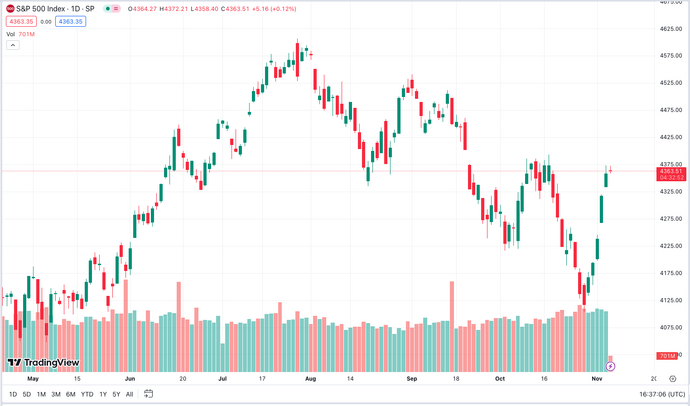The S&P 500 is about to break a crucial resistance point. Will this continue its rally?

The S&P 500, the index that tracks the 500 largest US companies, is pointing back up after a week of hovering in correction territory. The question everyone is asking now is: will the S&P 500 continue to grow? Or is it just a temporary rally?
These questions are composed of many layers. First of all, let’s look at some raw numbers.
The S&P 500 has grown 14.21% Year-to-Date, a much better performance than last year when it dropped over 1,200 points from its peak. In the second half of 2023, however, the S&P 500 has been slowly declining, with temporary rallies followed by longer contractions.
This could indicate that the current rally (+4.67% in 5 days) is just part of this larger correction curve.
If, however, we look at the 6-month graph, it’s possible to see that the S&P 500 is about to break a point of resistance, reaching a new high and possibly reversing the trend.

So which one is it? Where is the S&P 500 going next?
As uncertain as the Fed
The S&P 500 is usually linked to the monetary policy of the Federal Reserve. This is an uncomfortable truth markets don’t like to think about, but it’s a fact that a tight Fed policy caused more S&P 500 bankruptcies this year than the last one.
As a matter of fact, the Fed’s tightening policy might have reached its last act, but it’s not over yet. With inflation firmly below 4% and hovering around the 3% mark, the Federal Reserve might implement one last hike in 2023 before leaving interest rates unchanged in 2024.
This is the most likely course of action by the Fed, as outlined by Chairman Jerome Powell himself. The strongest indicator that another hike is on its way is a better-than-expected American GDP in the last quarter. The economy remains resilient despite 19 months of tightening policy.
Powell probably believes the economy can handle another hike without falling into a recession. Other analysts are not so sure, and instead give a US recession in 2024 almost for granted.
This will be the most important driver of the S&P 500 in the coming months.
Moreover, the S&P 500 is also connected to the performance of long-term bonds. When these assets rise in return (they recently reached a new high at 5%), the S&P 500 usually enters a bearish phase.
Recently, US bonds have started receding, though it most likely is a temporary situation. For this reason, Morgan Stanley strategist Wilson believes the current S&P 500 rally will not last longer than a couple of weeks.





